Experimental Study of Extracting Weak Infrared Signals of Rock Induced by Cyclic Loading under the Strong Interference Background
Abstract
:1. Introduction
2. Materials and Methods
2.1. Experimental System
2.2. Experimental Environment
2.2.1. Monotonic Changes in the Ambient Temperature
2.2.2. Fluctuations in Ambient Temperature
2.3. Experimental Method
2.4. Data-Processing Method
2.4.1. Difference Processing
2.4.2. Wavelet Analysis
2.4.3. Statistical Analysis
3. Results
3.1. Stress-Strain Analysis
3.2. Photos for Experimental Conditions
3.3. Temperature Variation and ΔAIRT
3.3.1. Results in ‘EM1’
3.3.2. Results in ‘EF2’
3.4. Statistical Results
4. Discussion
4.1. The Relationship between the Change in the TIR and Stress
4.2. The Relationship between AIRT and Physical Temperature
4.3. Significance of the Experimental Results
4.4. The Difficulty and Further Improvement
- (1)
- The cyclic loading mode and the relatively high loading rate in this study are just one type of crustal stress condition. However, the actual crustal stress conditions are complex and variable, and the loading rate is uncontrollable in reality. Additionally, the wavelet method is not suitable for extracting the TIR signal related to the aperiodic crustal stress from a relatively strong background.
- (2)
- In addition, most of IR radiation recorded by satellite sensors is emitted by vegetation, soil, and unconsolidated sediments on the Earth’s surface. Moreover, the received radiation is influenced by many nonseismic factors including climate, topography and landscape, geophysics, and geography. It is difficult to observe the TIR signal from the loaded rock on the ground directly.
- (3)
- The distance between the spectrometer and the specimen is at the level of meters in the experimental condition, which is much less than the orbit height at the level of hundreds of kilometres for satellite observations. The influence of the atmosphere effect is inevitable.
- (1)
- For the experimental design, the cyclic loading mode at a relative slow rate can be considered to simulate the actual crustal stress condition [46]. In addition, more types of rock samples can be selected to confirm the magnitude of the stress-related TIR signal.
- (2)
- (3)
5. Conclusions
- (1)
- The AIRT is strongly influenced by the ambient temperature and environmental radiation. The AIRT related to stress is relatively weak and submerged by the ambient temperature, which cannot be identified directly.
- (2)
- The stress-induced infrared radiation signal from the cyclic loaded rock can be extracted via wavelet analysis method. The correlation coefficient between the decomposed ΔAIRT and stress is larger than 0.8, and the amplitude of the extracted stress-induced infrared radiation is close to the theoretical result. Therefore, it is feasible to extract the weak TIR signals induced by stress in a strong interference background.
Author Contributions
Funding
Acknowledgments
Conflicts of Interest
References
- Shi, C.; Lou, Y.; Zhang, H.; Zhao, Q.; Geng, J.; Wang, R.; Fang, R. Seismic deformation of the 8.0 Wenchuan earthquake from high-rate GPS observations. Adv. Space Res. 2010, 46, 228–235. [Google Scholar] [CrossRef]
- Chen, S.W.; Wang, X.S.; Sato, M. Urban Damage Level Mapping Based on Scattering Mechanism Investigation Using Fully Polarimetric SAR Data for the 3.11 East Japan Earthquake. IEEE Trans. Geosci. Remote Sens. 2016, 54, 6919–6929. [Google Scholar] [CrossRef]
- Luo, H.P.; Chen, T. Three-Dimensional Surface Displacement Field Associated with the 25 April 2015 Gorkha, Nepal, Earthquake: Solution from Integrated InSAR and GPS Measurements with an Extended SISTEM Approach. Remote Sens. 2016, 8, 559. [Google Scholar] [CrossRef]
- Sun, W.; Miura, S.; Sato, T.; Sugano, T.; Freymueller, J.; Kaufman, M.; Larsen, C.F.; Cross, R.; Inazu, D. Gravity changes during the Alaska earthquake. J. Geophys. Res. 2010, 115, B12406–B12423. [Google Scholar] [CrossRef]
- Gorny, V.I.; Sal’Man, A.G.; Tronin, A.A.; Shilin, B.V. Outgoing infrared radiation of the earth as an indicator of seismic activity. Proc. Acad. Sci. USSR 1988, 301, 67–69. [Google Scholar]
- Ouzounov, D.; Bryant, N.; Logan, T.; Pulinets, S.; Taylor, P. Satellite thermal IR phenomena associated with some of the major earthquakes in 1999–2003. Phys. Chem. Earth 2006, 31, 154–163. [Google Scholar] [CrossRef]
- Ouzounov, D.; Liu, D.F.; Kang, C.L.; Cervone, G.; Kafatos, M.; Taylor, P. Outgoing long wave radiation variability from IR satellite data prior to major earthquakes. Tectonophysics 2007, 431, 211–220. [Google Scholar] [CrossRef]
- Saraf, A.K.; Rawat, V.; Banerjee, P.; Choudhury, S.; Panda, S.K.; Das, J.D. Satellite detection of earthquake thermal infrared precursors in Iran. Nat. Hazards 2008, 47, 119–135. [Google Scholar] [CrossRef]
- Saraf, A.K.; Rawat, V.; Das, J.; Zia, M.; Sharma, K. Satellite detection of thermal precursors of Yamnotri, Ravar and Dalbandin earthquakes. Nat. Hazards 2012, 61, 861–872. [Google Scholar] [CrossRef]
- Tronin, A.A. Satellite remote sensing in seismology. A review. Remote Sens. 2010, 2, 124–150. [Google Scholar] [CrossRef]
- Piroddi, L.; Ranieri, G. Night Thermal Gradient: A New Potential Tool for Earthquake Precursors Studies. An Application to the Seismic Area of L’Aquila (Central Italy). IEEE J. Sel. Top. Appl. Earth Obs. Remote Sens. 2012, 5, 307–312. [Google Scholar] [CrossRef]
- Wu, L.X.; Qin, K.; Liu, S.J. GEOSS-based thermal parameters analysis for earthquake anomaly recognition. Proc. IEEE 2012, 100, 2891–2907. [Google Scholar] [CrossRef]
- Qin, K.; Wu, L.X.; Zheng, S.; Liu, S.J. A Deviation-Time-Space-Thermal (DTS-T) method for Global Earth Observation System Of Systems (GEOSS)-based earthquake anomaly recognition: Criterions and quantify indices. Remote Sens. 2013, 5, 5143–5151. [Google Scholar] [CrossRef]
- Eleftheriou, A.; Filizzola, C.; Genzano, N.; Lacava, T.; Lisi, M.; Paciello, R.; Pergola, N.; Vallianatos, F.; Tramutoli, V. Long-term RST analysis of anomalous TIR sequences in relation with earthquakes occurred in Greece in the period 2004–2013. Pure Appl. Geophys. 2016, 173, 285–303. [Google Scholar] [CrossRef]
- Fulton, P.M.; Brodsky, E.E.; Kano, Y.; Mori, J.; Chester, F.; Ishikawa, T.; Harris, R.N.; Lin, W.; Eguchi, N.; Toczko, S. Low coseismic friction on the Tohoku-Oki fault determined from temperature measurements. Science 2013, 342, 1214–1217. [Google Scholar] [CrossRef] [PubMed] [Green Version]
- Li, H.B.; Xue, L.; Brodsky, E.E.; Mori, J.J.; Fulton, P.M.; Wang, H.; Kano, Y.; Yun, K.; Harris, R.N.; Gong, Z. Long-term temperature records following the Mw 7.9 Wenchuan (China) earthquake are consistent with low friction. Geology 2015, 43, 163–166. [Google Scholar] [CrossRef] [Green Version]
- Ma, J.; Wang, Y.P.; Chen, S.Y.; Liu, P.X.; Liu, L.Q. Insights into correlation between satellite infrared information and fault activities. Prog. Nat. Sci. 2006, 16, 1467–1475. [Google Scholar] [CrossRef]
- Chen, S.Y.; Ma, J.; Liu, P.X.; Liu, L.Q.; Hu, X.Y. Exploring co-seismic thermal response of Wenchuan earthquake by using Land Surface Temperatures of Terra and Aqua Satellites. Chin. J. Geophys. 2013, 56, 3788–3799. (In Chinese) [Google Scholar] [CrossRef]
- Chen, S.Y.; Liu, P.X.; Liu, L.Q.; Ma, J. A phenomenon of ground temperature change prior to LuShan earthquake observed in KangDing. Seismol. Geol. 2013, 35, 634–640. (In Chinese) [Google Scholar] [CrossRef]
- Chen, S.Y.; Liu, P.X.; Liu, L.Q.; Ma, J. Bedrock temperature as a potential method for monitoring change in crustal stress: Theory, in situ measurement, and a case history. J. Asian Earth Sci. 2016, 123, 22–33. [Google Scholar] [CrossRef]
- Geng, N.G.; Cui, C.Y.; Deng, M.D. Remote sensing detection in rock fracture experiment and the beginning of remote sensing rock mechanics. Acta Seismol. Sin. 1992, 14, 645–652. (In Chinese) [Google Scholar]
- Wu, L.X.; Cui, C.Y.; Geng, N.G.; Wang, J.Z. Remote sensing rock mechanics (RSRM) and associated experimental studies. Int. J. Rock Mech. Min. Sci. 2000, 37, 879–888. [Google Scholar] [CrossRef]
- Wu, L.X.; Liu, S.J.; Wu, Y.H.; Wang, C.Y. Precursors for rock fracturing and failure-part I: IRR image abnormalities. Int. J. Rock Mech. Min. Sci. 2006, 43, 473–482. [Google Scholar] [CrossRef]
- Wu, L.X.; Liu, S.J.; Wu, Y.H.; Wang, C.Y. Precursors for rock fracturing and failure-part II: IRRT-curve abnormalities. Int. J. Rock Mech. Min. Sci. 2006, 43, 483–493. [Google Scholar] [CrossRef]
- Yang, X.Q.; Lin, W.R.; Tadai, O.; Zeng, X.; Yu, C.H.; Ye, H.C.; Li, H.B.; Wang, H. Experimental and numerical investigation of the temperature response to stress changes of rocks. J. Geophys. Res. Solid Earth 2017, 122, 5101–5117. [Google Scholar] [CrossRef] [Green Version]
- Wang, C.L.; Lu, Z.J.; Liu, L.; Chuai, X.S.; Lu, H. Predicting points of the infrared precursor for limestone failure under uniaxial compression. Int. J. Rock Mech. Min. Sci. 2016, 88, 34–43. [Google Scholar] [CrossRef]
- Sun, X.M.; Xu, H.C.; He, M.C.; Zhang, F. Experimental investigation of the occurrence of rockburst in a rock specimen through infrared thermography and acoustic emission. Int. J. Rock Mech. Min. Sci. 2017, 93, 250–259. [Google Scholar] [CrossRef]
- Ma, J.; Sherman, S.I.; Guo, Y. Identification of meta-instable stress state based on experimental study of evolution of the temperature field during stick-slip instability on a 5° bending fault. Sci. Chin. Earth Sci. 2012, 55, 869–881. [Google Scholar] [CrossRef]
- Ren, Y.Q.; Liu, P.X.; Ma, J.; Chen, S.Y. Experimental study on evolution of thermal field of en echelon fault during the meta-instability stage. Chin. J. Geophys. 2013, 56, 2348–2357. (In Chinese) [Google Scholar] [CrossRef]
- He, M.C. Physical modeling of an underground roadway excavation in geologically 45° inclined rock using infrared thermography. Eng. Geol. 2011, 121, 165–176. [Google Scholar] [CrossRef]
- Mineo, S.; Pappalardo, G.; Rapisarda, F.; Cubito, A.; Maria, G.D. Integrated geostructural, seismic and infrared thermography surveys for the study of an unstable rock slope in the peloritani chain (ne sicily). Eng. Geol. 2015, 195, 225–235. [Google Scholar] [CrossRef]
- Pappalardo, G.; Mineo, S.; Calcaterra, D. Geomechanical analysis of unstable rock wedges by means of geostructural and infrared thermography surveys. Ital. J. Eng. Geol. Environ. 2017, 1, 93–101. [Google Scholar] [CrossRef]
- Freund, F.T.; Takeuchi, A.; Lau, B.W.S.; Al-Manaseer, A.; Fu, C.C.; Bryant, N.A.; Ouzounov, D. Stimulated infrared emission from rocks: Assessing a stress indicator. eEarth 2007, 2, 7–16. [Google Scholar] [CrossRef]
- Freund, F.T. Pre-earthquake signals: Underlying physical processes. J. Asian Earth Sci. 2011, 41, 383–400. [Google Scholar] [CrossRef]
- Liu, S.J.; Wu, L.X.; Feng, Z.; Xu, Z.Y. Thermal infrared spectral variation and sensitive waveband of quartzy sandstone under pressure. Spectrosc. Spectr. Anal. 2012, 32, 78–82. (In Chinese) [Google Scholar] [CrossRef]
- Xu, Z.Y.; Liu, S.J.; Wu, L.X.; Feng, Z. Stress-related thermal infrared spectral variation and sensitive waveband of granite. J. Infrared Millim. Waves 2013, 32, 44–49. [Google Scholar] [CrossRef]
- Huang, J.W.; Liu, S.J.; Xu, Z.Y.; Ma, C.Y.; Wu, L.X. Experimental study on the influence of the radiation background on the variation in thermal infrared radiance of loaded rock. Spectrosc. Spectr. Anal. 2018, 38, 4222–4225. (In Chinese) [Google Scholar] [CrossRef]
- Huang, J.W.; Liu, S.J.; Gao, X.; Yang, Z.C.; Ni, Q.; Wu, L.X. Experimental Study of the Thermal Infrared Emissivity Variation of Loaded Rock and Its Significance. Remote Sens. 2018, 10, 818. [Google Scholar] [CrossRef]
- Tanaka, S. Tidal triggering of earthquakes prior to the 2011 Tohoku-Oki earthquake. Geophys. Res. Lett. 2012, 39, 7. [Google Scholar] [CrossRef]
- Ma, W.Y.; Kong, X.Z.; Kang, C.L.; Zhong, X.H.; Wu, H.Y.; Zhan, X.S.; Joshi, M. Research on the changes of the tidal force and the air temperature in the atmosphere of Lushan (China) MS7.0 earthquake. Therm. Sci. 2015, 19, S487–S493. [Google Scholar] [CrossRef]
- Kilston, S.; Knopoff, L. Lunar-solar periodicities of large earthquakes in southern California. Nature 1983, 304, 21–25. [Google Scholar] [CrossRef]
- Li, F.; Zhang, Y.G.; Liu, J.R.; Zhang, L.; Fang, S.H. The dynamical response characteristics of elastic–plastic coal under dynamic load. J. Nat. Gas Sci. Eng. 2016, 29, 497–505. [Google Scholar] [CrossRef]
- Herrendörfer, R.; Dinther, Y.V.; Gerya, T.; Dalguer, L.A. Earthquake supercycle in subduction zones controlled by the width of the seismogenic zone. Nat. Geosci. 2015, 8, 471–473. [Google Scholar] [CrossRef]
- Nadeau, R.M.; Foxall, W.; Mcevilly, T.V. Clustering and periodic recurrence of micro-earthquakes on the San Andreas fault at Park field California. Science 1995, 267, 503–507. [Google Scholar] [CrossRef] [PubMed]
- Perfettini, H.; Avouac, J.P.; Tavera, H.; Kositsky, A.; Nocquet, J.M.; Bondoux, F.; Chlieh, M.; Sladen, A.; Audin, L.; Farber, D.L.; et al. Seismic and aseismic slip on the central Peru megathrust. Nature 2010, 465, 78–81. [Google Scholar] [CrossRef] [PubMed]
- Song, Z.P.; Yin, J.Y.; Xue, Y.; Zhang, G.M.; Liu, J.; Zhu, Y.Q.; Zhang, Y.X. The global and sub-zone period characteristics for large earthquakes. Chin. J. Geophys. 2013, 56, 1868–1876. (In Chinese) [Google Scholar] [CrossRef]
- Liu, S.J.; Xu, Z.Y.; Wei, J.L.; Huang, J.W.; Wu, L.X. Experimental Study on Microwave Radiation from Deforming and Fracturing Rock under Loading Outdoor. IEEE Trans. Geosci. Remote Sens. 2016, 54, 5578–5587. [Google Scholar] [CrossRef]
- Kylili, A.; Fokaides, P.A.; Christou, P.; Kalogirou, S.A. Infrared thermography (IRT) applications for building diagnostics: A review. Appl. Energy 2014, 134, 531–549. [Google Scholar] [CrossRef]
- Ma, L.Q.; Sun, H.; Zhang, Y.; Zhou, T.; Li, K.; Guo, J.S. Characteristics of Infrared Radiation of Coal Specimens under Uniaxial Loading. Rock Mech. Rock Eng. 2016, 49, 1567–1572. [Google Scholar] [CrossRef]
- Sun, H.; Ma, L.Q.; Adeleke, N.; Zhang, Y. Background Thermal Noise Correction Methodology for Average Infrared Radiation Temperature of Coal under Uniaxial Loading. Infrared Phys. Technol. 2017, 81, 157–165. [Google Scholar] [CrossRef]
- Wang, J.X.; Tang, X.B. Wavelet denoise method applied in load spectrum analysis of engineering vehicles. Adv. Mater. Res. 2010, 108–111, 1320–1325. [Google Scholar] [CrossRef]
- Karamzadeh, N.; Doloei, G.J.; Reza, A.M. Automatic Earthquake Signal Onset Picking Based on the Continuous Wavelet Transform. IEEE Trans. Geosci. Remote Sens. 2013, 51, 2666–2674. [Google Scholar] [CrossRef]
- Chen, S.Y.; Liu, P.X.; Liu, L.Q.; Ma, J.; Chen, G.Q. Wavelet Analysis of Thermal Infrared Radiation of Land Surface and Its Implication in the Study of Current Tectonic Activities. Chin. J. Geophys. 2006, 49, 717–723. (In Chinese) [Google Scholar] [CrossRef]
- Chen, S.Y.; Liu, P.X.; Guo, Y.S.; Liu, L.Q.; Ma, J. An experiment on temperature variations in sandstone during biaxial loading. Phys. Chem. Earth 2015, 85–86, 3–8. [Google Scholar] [CrossRef]
- Thomson, W. On dynamical theory of heat. Philos. Mag. 1852, 4, 424–434. [Google Scholar] [CrossRef]
- Zhang, Y.S.; Guo, X.; Zhong, M.J.; Shen, W.R.; Li, W.; He, B. Wenchuan earthquake: Brightness temperature changes from satellite infrared information. Chin. Sci. Bull. 2010, 55, 1917–1924. [Google Scholar] [CrossRef]
- Zhang, Y.S.; Guo, X.; Wei, C.X.; Shen, W.R.; Hui, S.X. The characteristics of seismic thermal radiation of Japan Ms 9.0 and Myanmar Ms 7.2 earthquake. Chin. J. Geophys. 2011, 54, 2575–2580. [Google Scholar] [CrossRef]
- Guo, X.; Zhang, Y.S.; Wei, C.X.; Zhong, M.J.; Zhang, X. Medium wave infrared brightness anomalies of Wenchuan 8.0 and Zhongba 6.8 earthquakes. Acta Geosci. Sin. 2014, 35, 338–344. [Google Scholar] [CrossRef]
- Zhang, X.; Zhang, Y.S.; Guo, X.; Wei, C.X.; Zhang, L.F. Analysis of thermal infrared anomaly in the Nepal Ms 8.1 earthquake. Earth Sci. Front. 2017, 24, 227–233. (In Chinese) [Google Scholar] [CrossRef]
- Xie, T.; Kang, C.L.; Ma, W.Y. Thermal infrared brightness temperature anomalies associated with the Yushu (China) Ms = 7.1 earthquake on 14 April 2010. Nat. Hazards Earth Syst. Sci. 2013, 13, 1105–1111. [Google Scholar] [CrossRef] [Green Version]
- Zoran, M.A.; Savastru, R.S.; Savastru, D.M. Satellite thermal infrared anomalies associated with strong earthquakes in the Vrancea area of Romania. Open Geosci. 2015, 7, 606–617. [Google Scholar] [CrossRef]
- Lu, X.; Meng, Q.Y.; Gu, X.F.; Zhang, X.D.; Xie, T.; Geng, F. Thermal infrared anomalies associated with multi-year earthquakes in the Tibet region based on China’s FY-2E satellite data. Adv. Space Res. 2016, 58, 989–1001. [Google Scholar] [CrossRef]
- Meganem, I.; Deville, Y.; Hosseini, S.; Deliot, P.; Briottet, X. Linear-Quadratic Blind Source Separation Using NMF to Unmix Urban Hyperspectral Images. IEEE Trans. Signal Process. 2014, 62, 1822–1833. [Google Scholar] [CrossRef]
- Zhong, Y.F.; Wang, X.Y.; Zhao, L.; Feng, R.Y.; Zhang, L.P.; Xu, Y.Y. Blind spectral unmixing based on sparse component analysis for hyperspectral remote sensing imagery. ISPRS J. Photogramm. Remote Sens. 2016, 119, 49–63. [Google Scholar] [CrossRef]
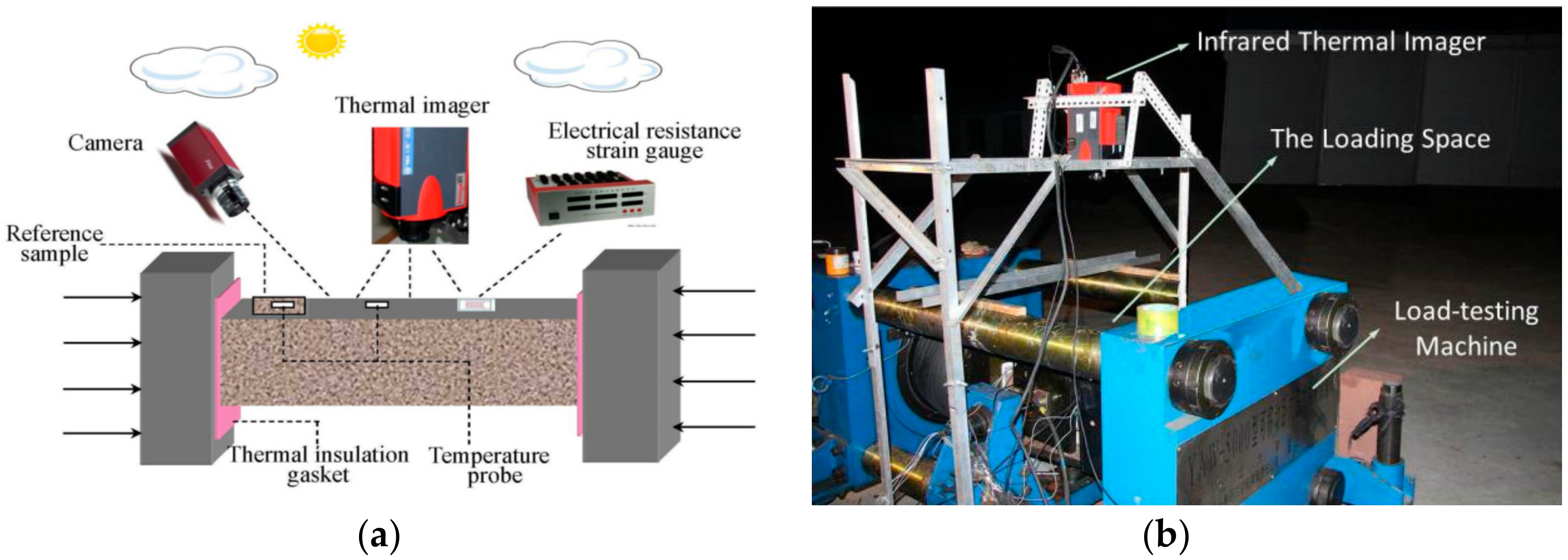
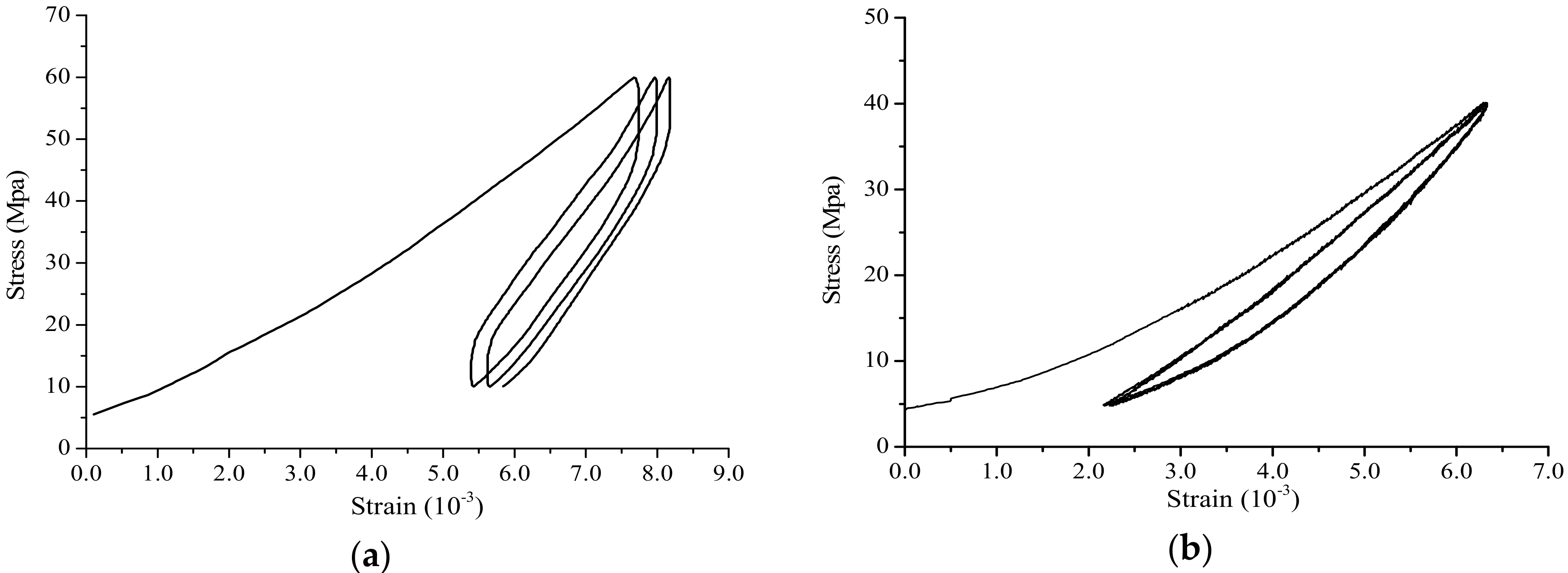
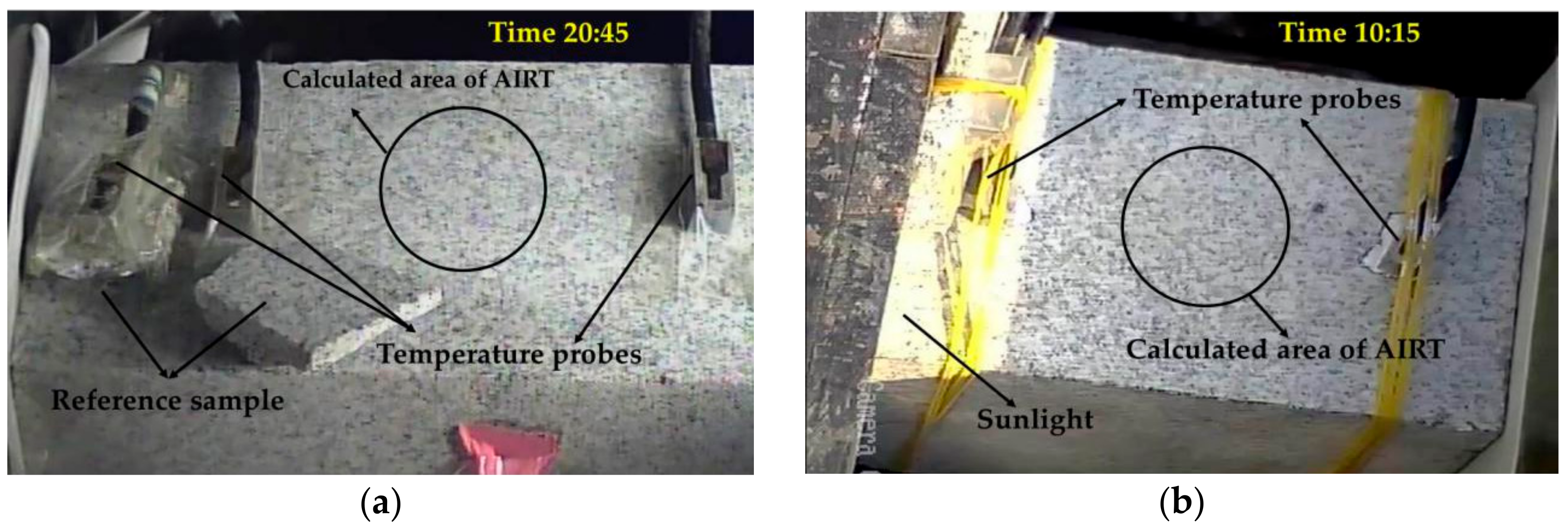


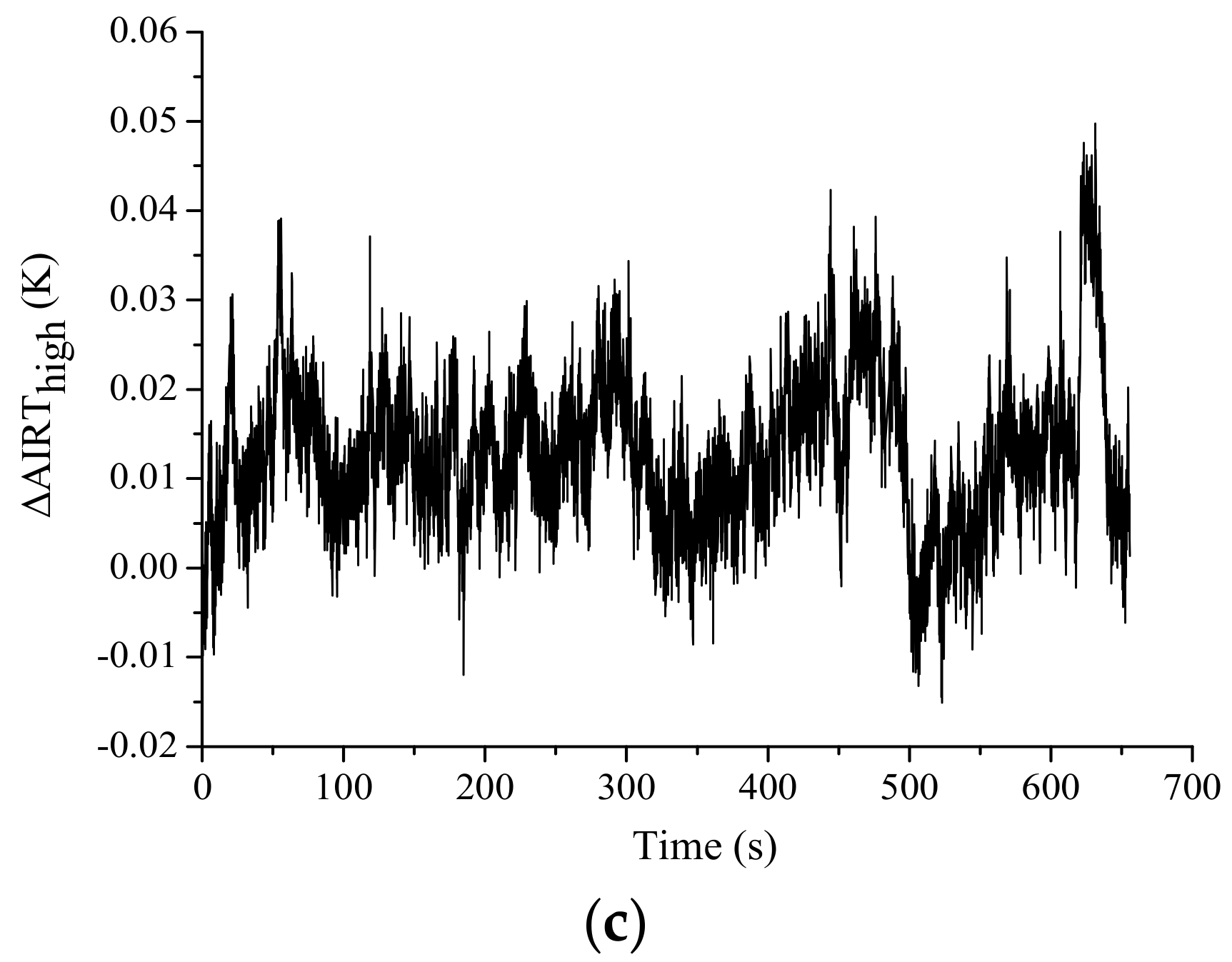
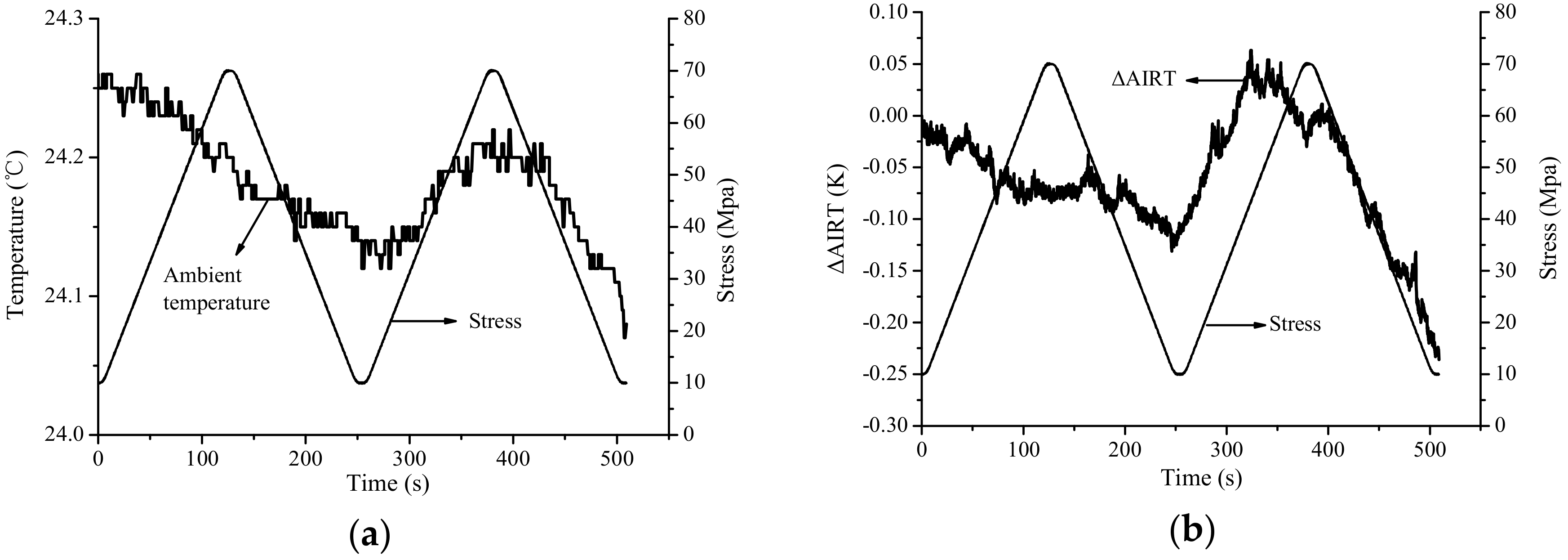
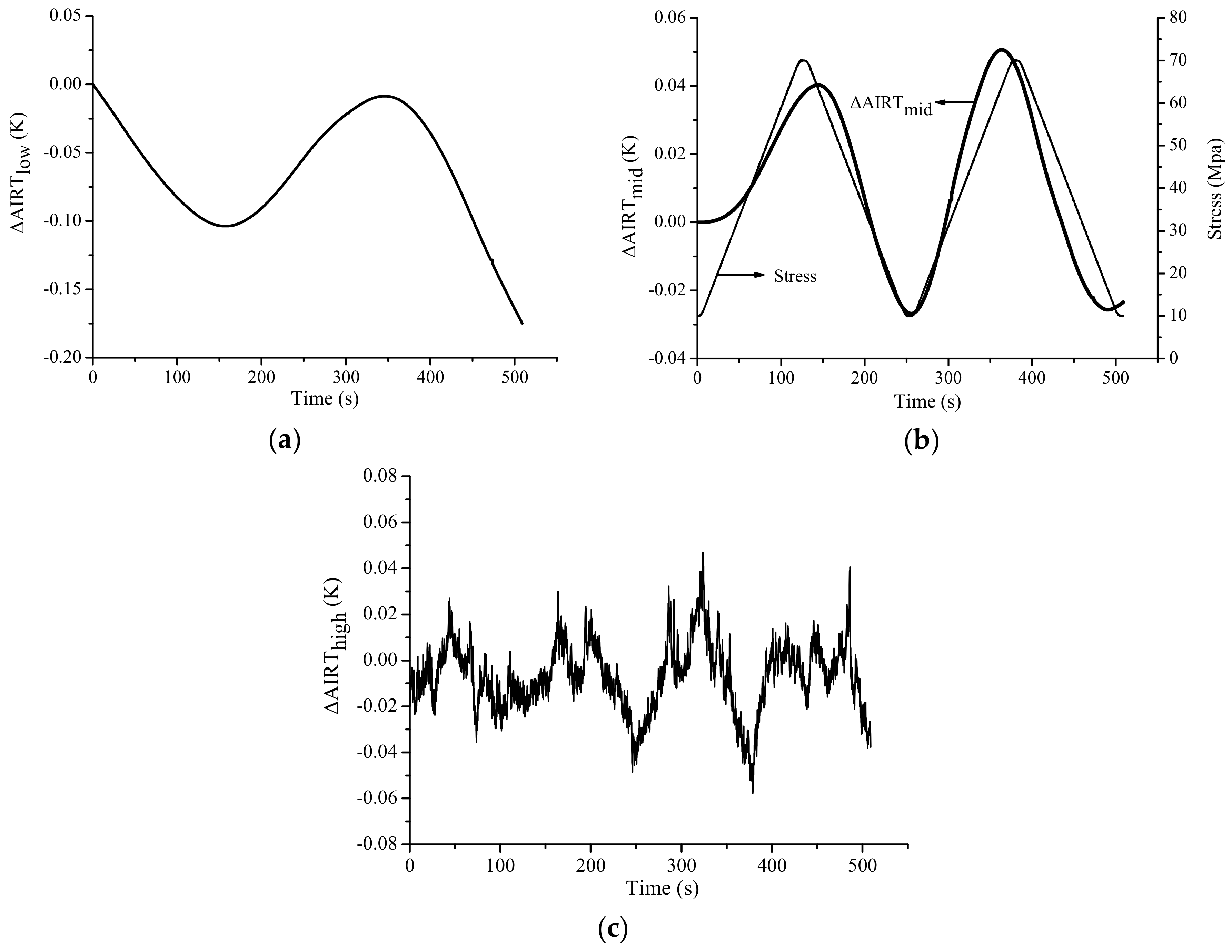
| Sample No. | Rock Type | Cyclic Loading Range (MPa) | Loading Rate (MPa/s) | Environmental Conditions |
|---|---|---|---|---|
| HG-1 | Granite | 10–60 | 0.3 | Night, ‘EM1’, Day 1 |
| HG-2 | 10–70 | 0.4 | Night, ‘EM1’, Day 2 | |
| HG-3 | 10–70 | 0.4 | Night, ‘EF2’, Day 3 | |
| HG-4 | 10–70 | 0.5 | Daytime, ‘EF2’, Day 3 | |
| SY-1 | Sandstone | 5–40 | 0.4 | Daytime, ‘EF2’, Day 1 |
| SY-2 | 5–40 | 0.4 | Daytime, ‘EF2’, Day 2 |
| Sample No. | Correlation Coefficient | Maximum Amplitude (K) | ||
|---|---|---|---|---|
| ΔAIRT | ΔAIRTmid | ΔAIRT | ΔAIRTmid | |
| HG-1 | 0.18 | 0.91 | 0.27 | 0.05 |
| HG-2 | 0.12 | 0.94 | 0.09 | 0.03 |
| HG-3 | 0.59 | 0.93 | 0.11 | 0.04 |
| HG-4 | 0.45 | 0.91 | 0.29 | 0.08 |
| SY-1 | 0.24 | 0.90 | 0.33 | 0.06 |
| SY-2 | 0.09 | 0.84 | 0.23 | 0.06 |
© 2018 by the authors. Licensee MDPI, Basel, Switzerland. This article is an open access article distributed under the terms and conditions of the Creative Commons Attribution (CC BY) license (http://creativecommons.org/licenses/by/4.0/).
Share and Cite
Huang, J.; Liu, S.; Ni, Q.; Mao, W.; Gao, X. Experimental Study of Extracting Weak Infrared Signals of Rock Induced by Cyclic Loading under the Strong Interference Background. Appl. Sci. 2018, 8, 1458. https://doi.org/10.3390/app8091458
Huang J, Liu S, Ni Q, Mao W, Gao X. Experimental Study of Extracting Weak Infrared Signals of Rock Induced by Cyclic Loading under the Strong Interference Background. Applied Sciences. 2018; 8(9):1458. https://doi.org/10.3390/app8091458
Chicago/Turabian StyleHuang, Jianwei, Shanjun Liu, Qiang Ni, Wenfei Mao, and Xiang Gao. 2018. "Experimental Study of Extracting Weak Infrared Signals of Rock Induced by Cyclic Loading under the Strong Interference Background" Applied Sciences 8, no. 9: 1458. https://doi.org/10.3390/app8091458






